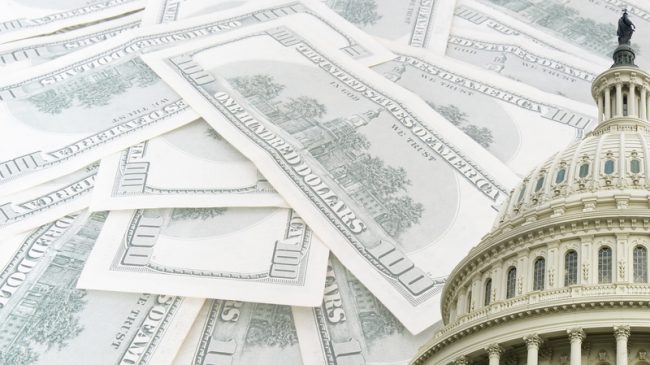Back to Taxpayer’s Guide > Next: 2. CJS
Summary: Over $41 billion is given to the Department of Agriculture, the Food and Drug Administration, and related agency programs
>> Spending
$20 billion for the Supplemental Nutrition Assistance Program. This money will go to provide additional food stamp money to the states, expanding benefits to individuals and families by 13.6 percent.
$11.8 billion for Rural Housing and Community Loan Guarantees. This money is to be used to guarantee private sector loans for rural housing. If a borrower defaults on their loan, the Housing and Community Facilities Program will pay the lender. This program furthermore allows individuals or families in rural areas to borrow up to 100% of money needed to cover a down payment on a home.
$3.14 billion for Rural Business-Cooperative Service. This will provide $3.12 billion for a loan program that helps businesses in rural communities, and it will also grant $20,000 to rural start up businesses.
$2.5 billion for the Rural Development Broadband Program. This money is supposed to help rural areas install broadband Internet.
$1.38 billion for Rural Water and Waste Disposal Loans. This offers loans to local governments for developing systems to drain water and get rid of sewage.
$650 million for Forest Service Improvements. This money for the U.S. Forest Service will broadly fund projects to remove hazardous waste, fix trails, bridges, and roads, and increase the energy efficiency of buildings near forest areas.
$500 million for Child Nutrition. This money funds a program providing special, nutritious food packages, nutrition education, to low-income children with health risks.
$500 million for Wildland Fire Management. The Agriculture Department gets this money to prevent and combat wildfires.
$340 million for Watershed Operations and Flood Prevention Program. The Department of Agriculture will get this money to work on flood prevention measures and fix land that has been flooded. The money is one part of a sweeping flood prevention program funded throughout the stimulus.
$244 million for the Farm Service Agency. This money will be largely for loans directly to farmers who can’t secure loans from banks. And $50 million is so the agency can modernize its Information Technology (IT) system.
$200 million for USDA Buildings. This money will fund $176 million of improvements and needed maintenance for the Agriculture Research Service and $24 million of improvements at the Department of Agriculture.
$150 million for the Emergency Food Assistance Program. This money will provide additional resources to food banks, soup kitchens, and similar organizations to help those struggling in difficult economic times.
$100 million for the National School Lunch Program. This money will go into the general fund of the program that provides “nutritionally balanced, low-cost or free lunches” to students in public and nonprofit private schools.
>> Commentary
The largest of the USDA funded programs-increased food stamp benefits that will give families an average of $38 more per month-also comes with a significant policy change on access. Under current law, adults without children can only receive food stamp benefits for three years, unless they qualify for a strict exemption. The stimulus removes that limit, opening up the program to a much larger cost increase down the road. While increased food stamp benefits would have been realized over time as costs adjusted for inflation, federal aid like this only serves to keep the costs of food in poor areas high. Businesses, knowing their customers have increased food stamp money, do not have incentives to lower prices to reflect decreased wages during a recession. This, in turn, hurts those who are not receiving federal aid.
The money provided here (and elsewhere in the stimulus) for housing loans only serves to perpetuate the government policies that were a significant part of creating the economic crisis in the first place. For decades, the government has actively promoted home ownership and developed programs to help people buy their own home. However, access to “no money down” loans on a house or access to cheap “subprime” mortgages has directly led to massive foreclosures, impacting housing prices and devaluing mortgage-backed securities. The reason is that many people who received loan help through these government programs never were able to afford a mortgage payment long-term in the first place. The Housing and Community Facilities Program and related initiatives are only continuing the problem.
Also, one might refer to Title I as the “Wilderness Bailout” as it expands the budgets of pre-existing government programs that have projects such as U.S. Forest Service trails and flood prevention systems. While on the surface noble, these programs are crowding out private investment. Why not have private firms fund the development of new sewage systems? What about privately operated national parks? These are ways businesses can invest in their communities, but only if the government isn’t there first. And the best part is that private companies have more incentive to operate cleaner, better parks than the government does because of contract terms and the desire to make money and succeed.
- Also see:
- Measure 50: Are Tobacco Taxes The Answer To Funding Children’s Health Programs?
- USDA Tries Pricing and Trading Environmental Benefits
- Funding the National Park System
More from Reason on Agriculture and the FDA.
>> Government Recovery Websites
Department of Agriculture: http://www.usda.gov/recovery
USDA ARRA Projects Map: http://www.usda.gov/recovery/map/
Taxpayer’s Guide > Next: 2. CJS
Written by: Anthony Randazzo. Please email with any comments or corrections.
